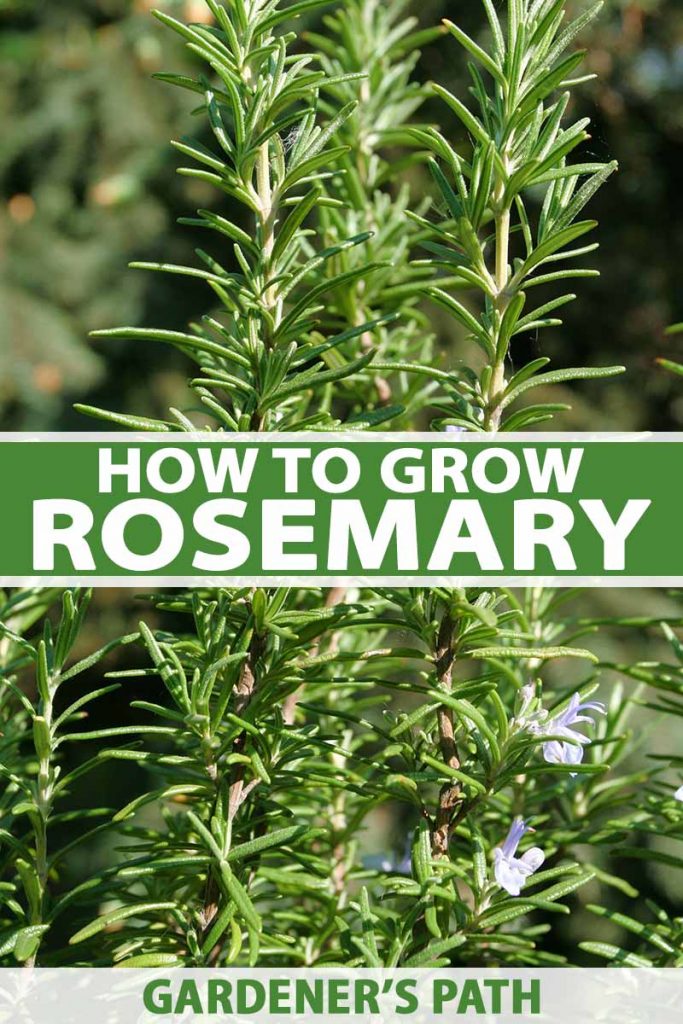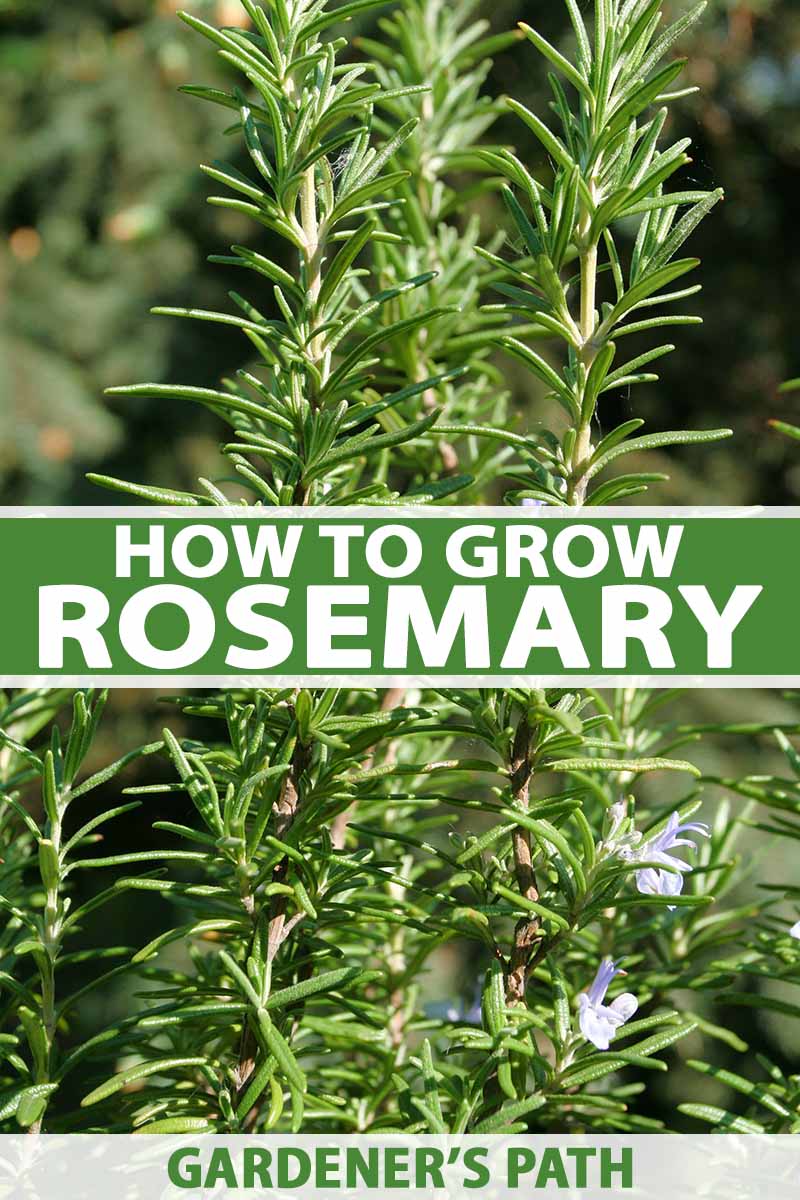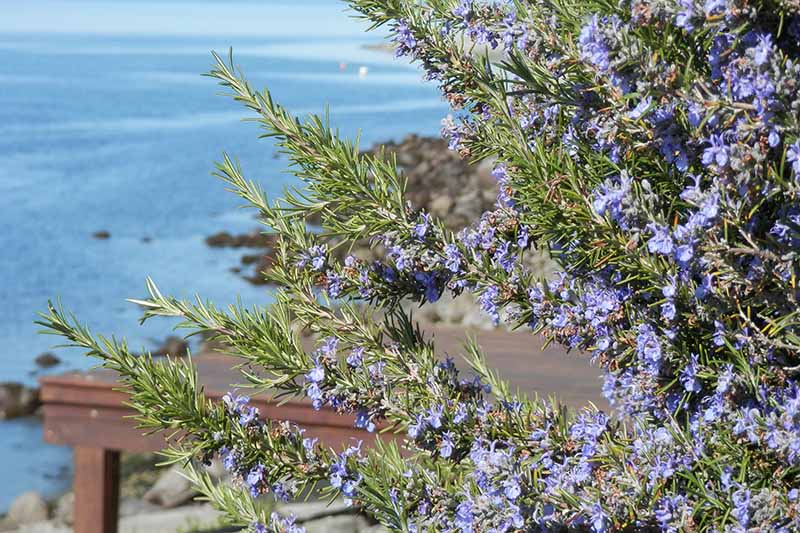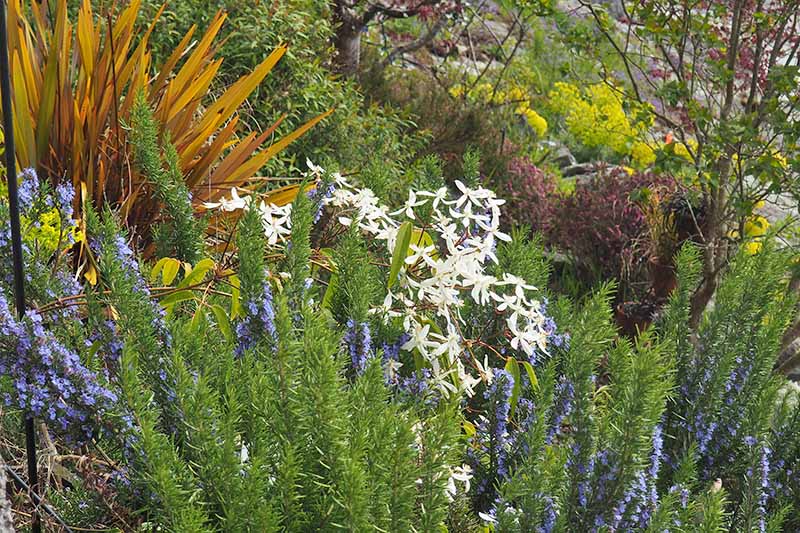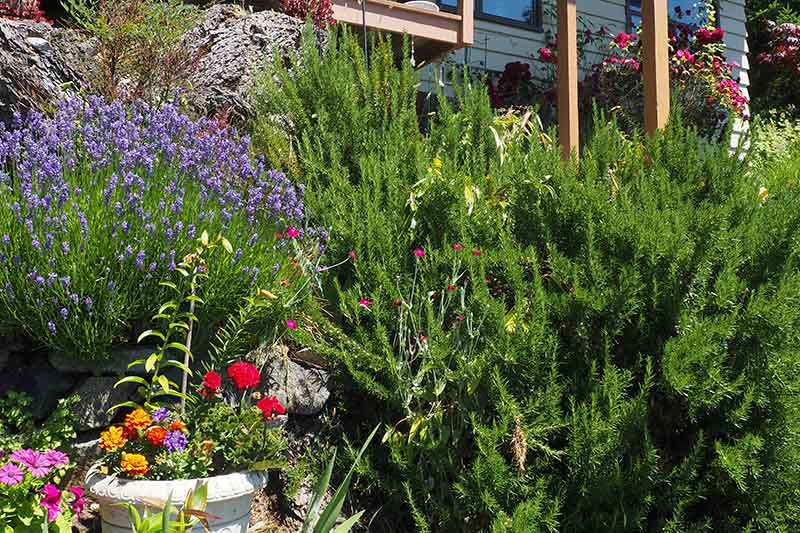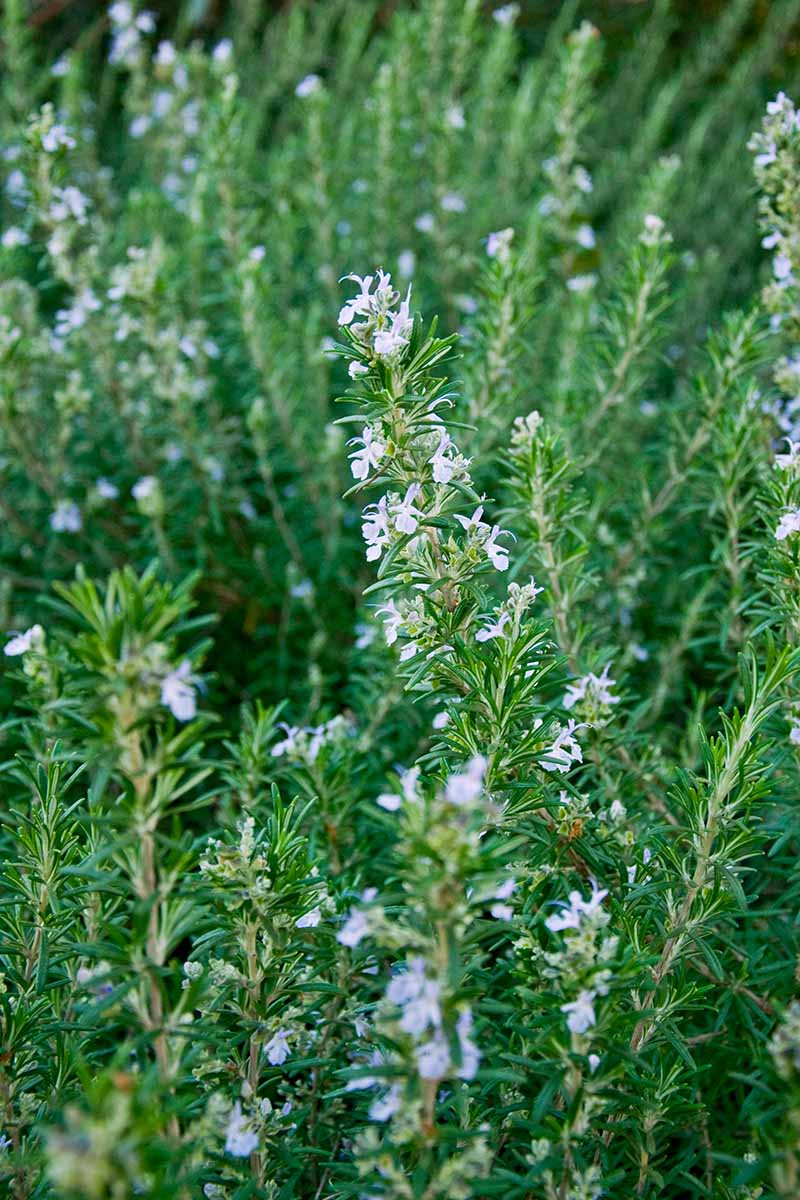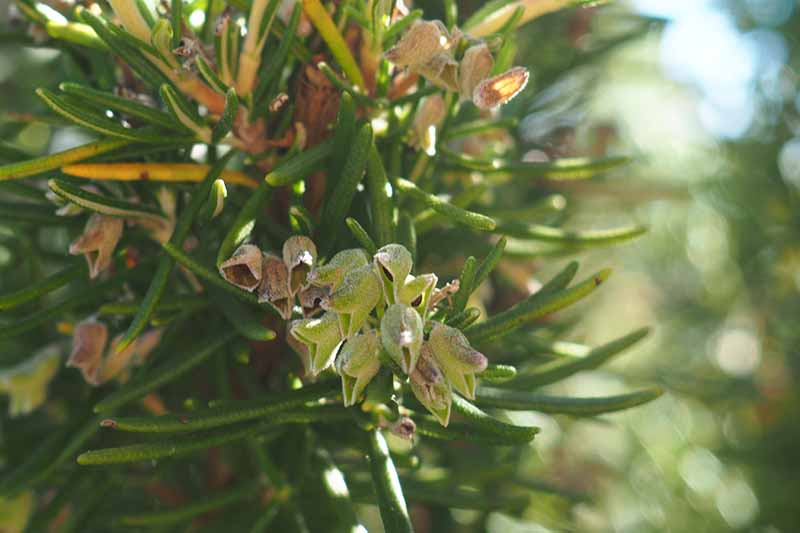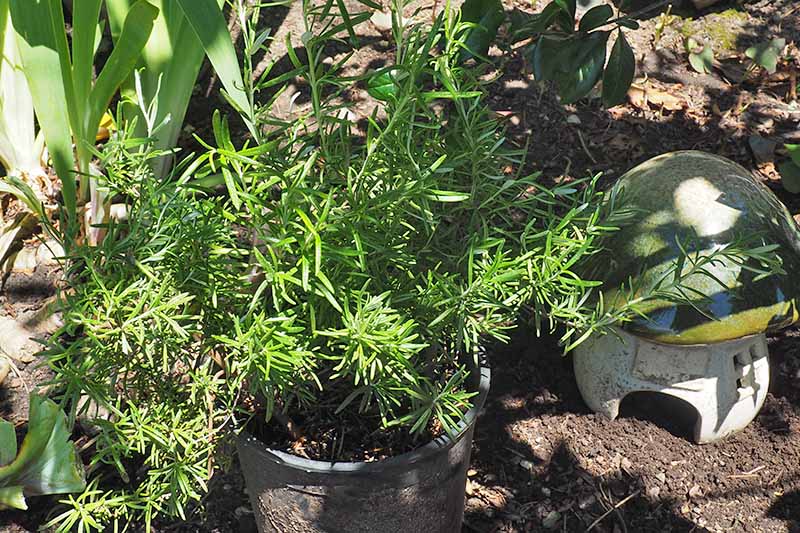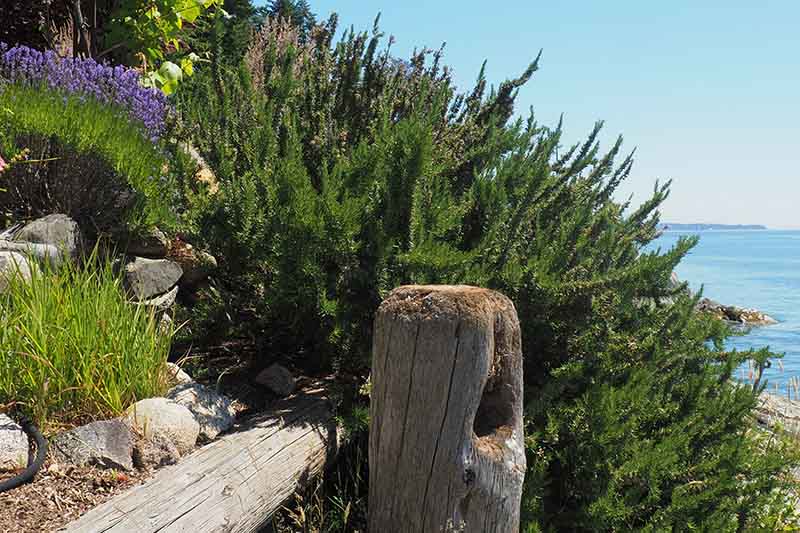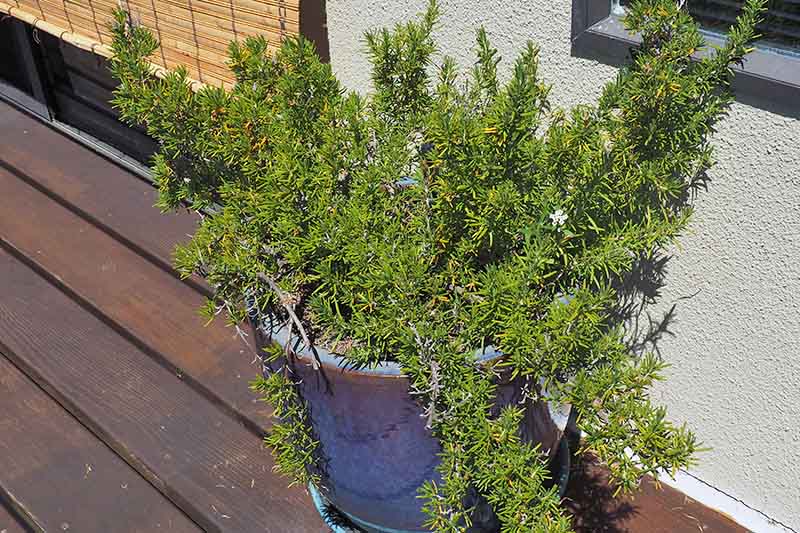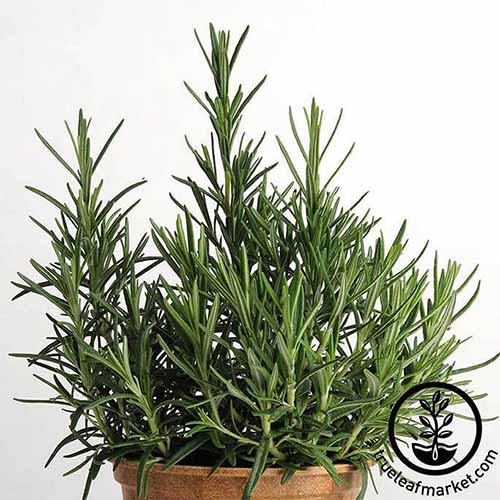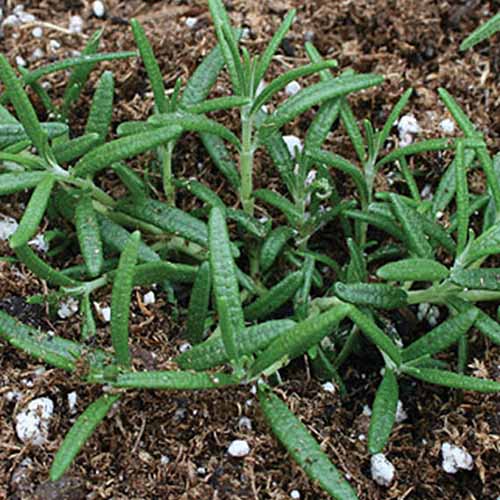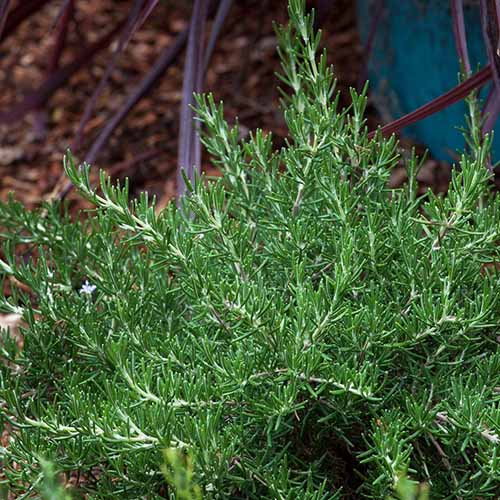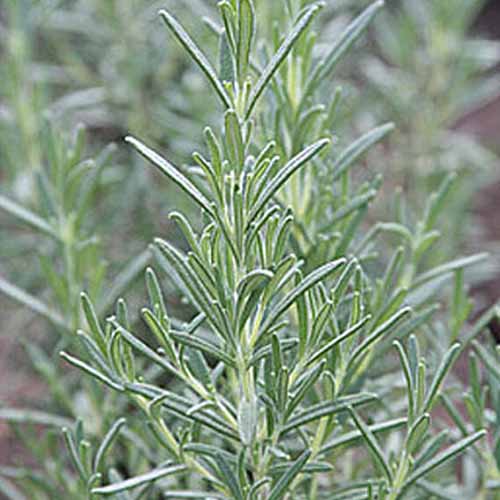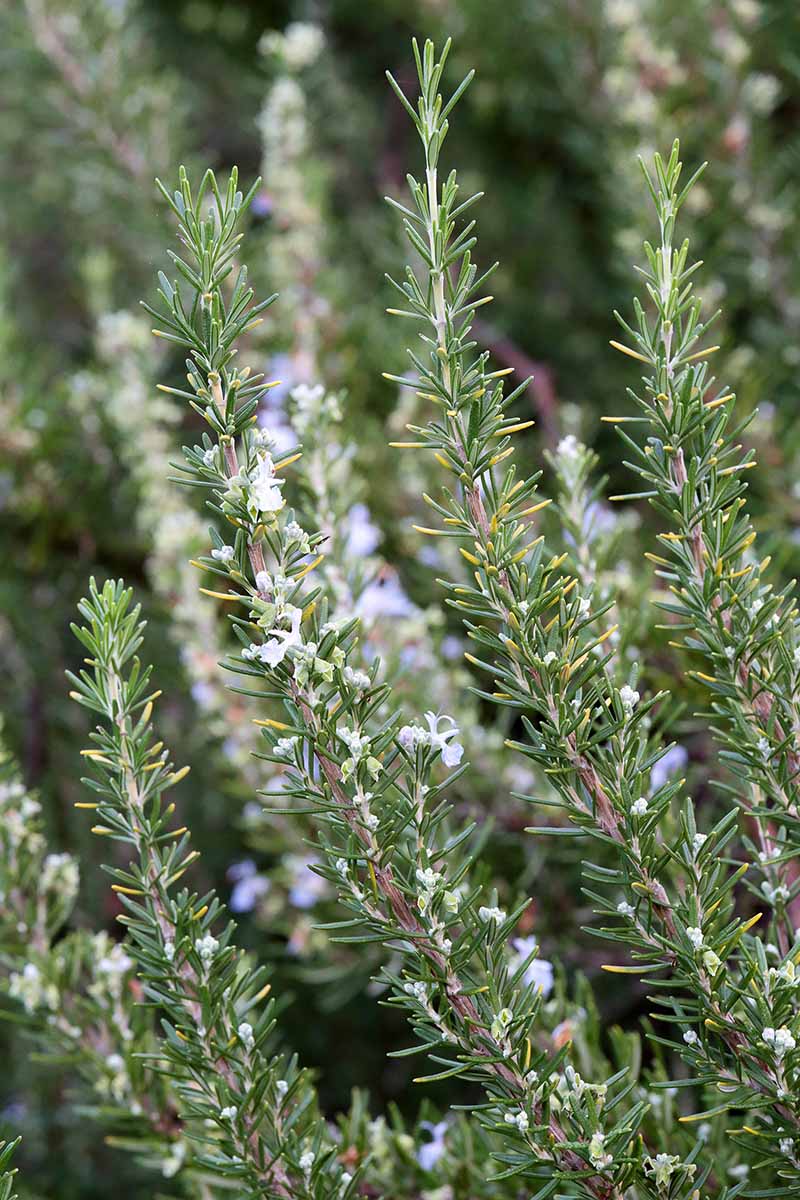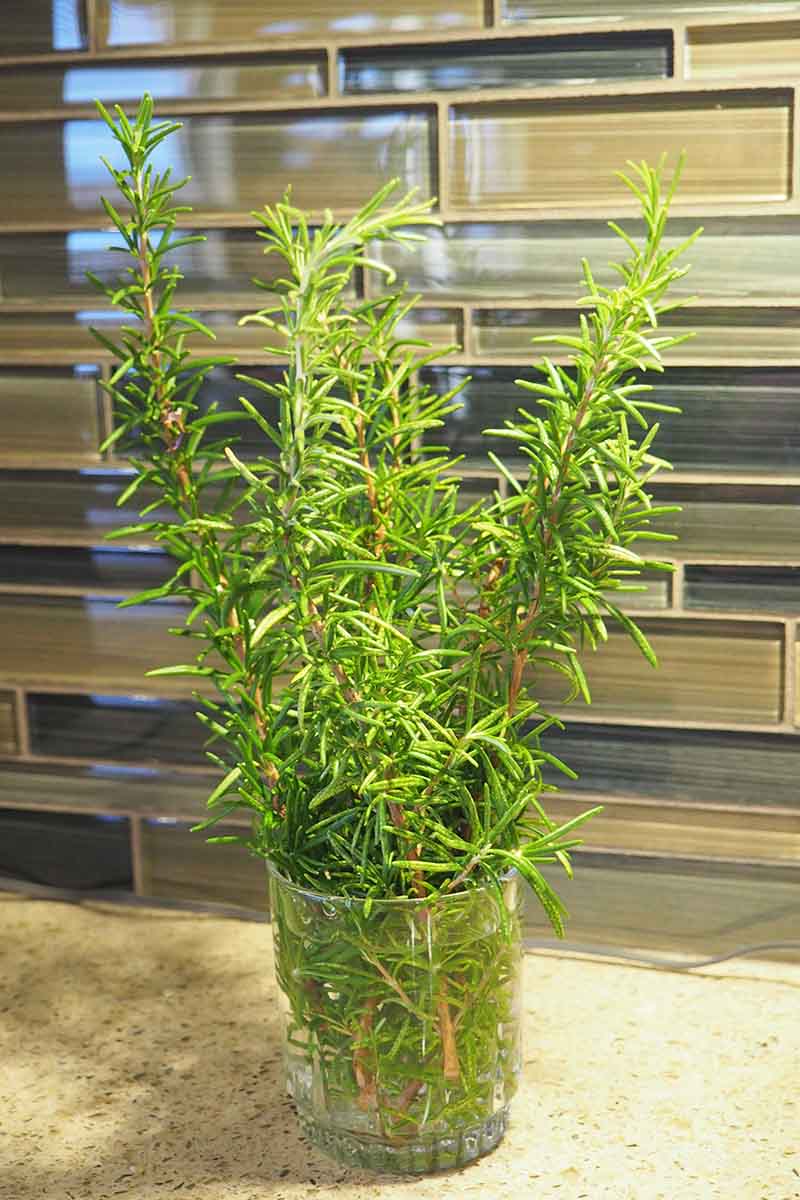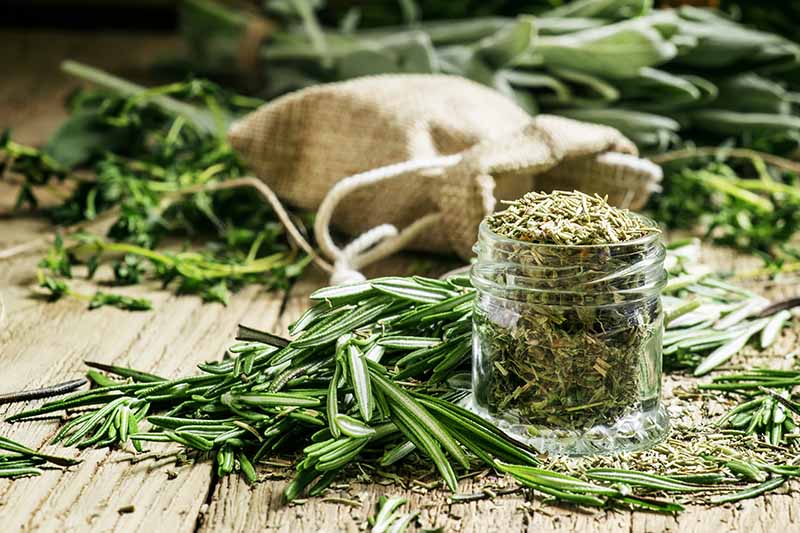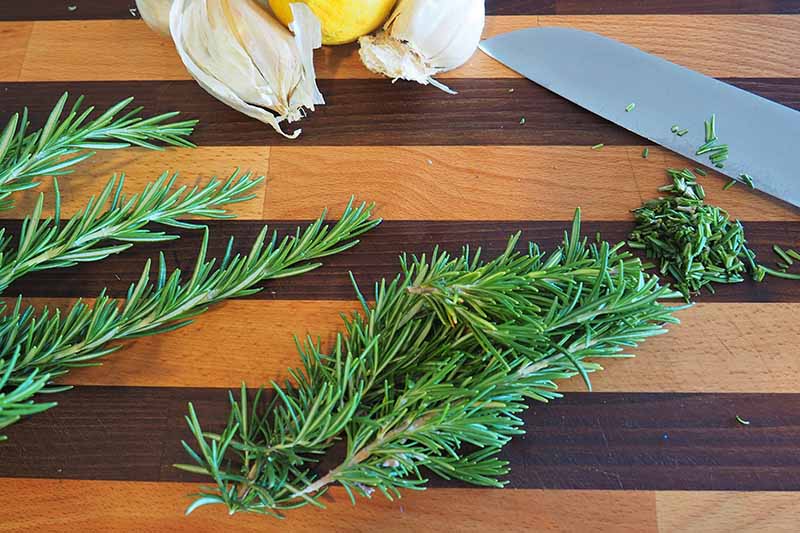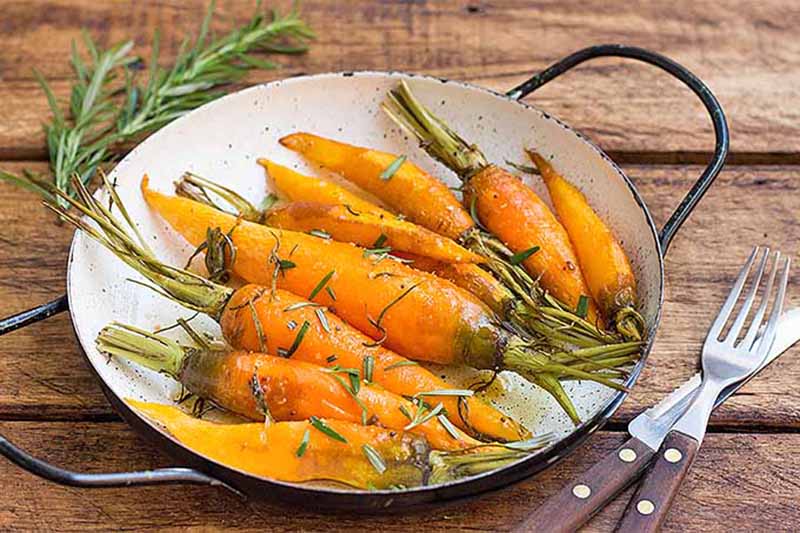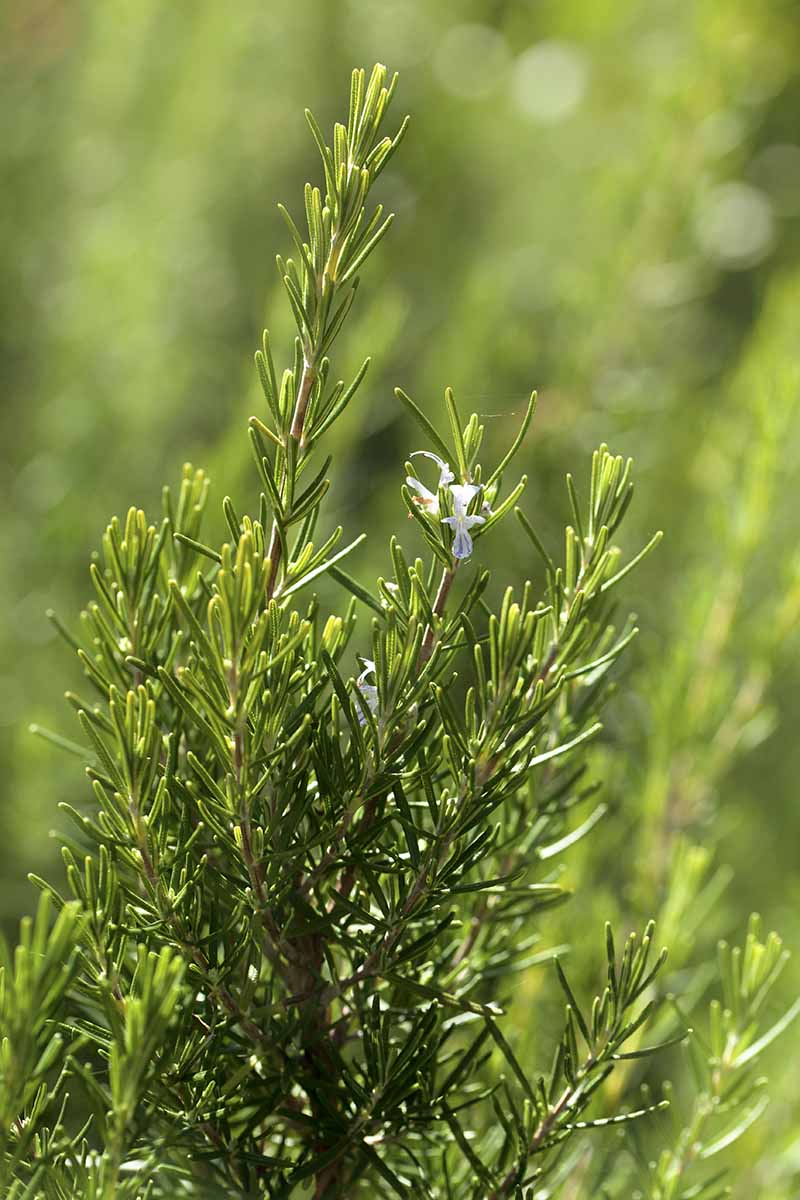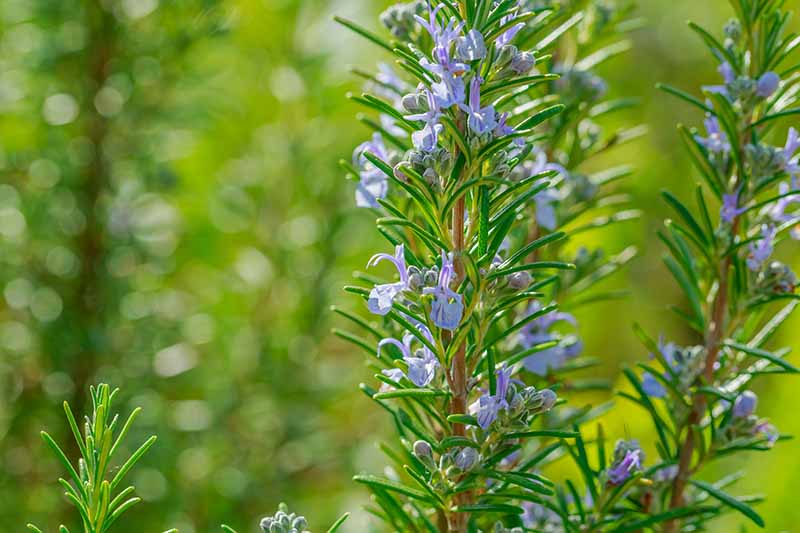As of 2017, thanks to botanical DNA testing, its taxonomy has changed – but not much else. It’s still the same beloved, fragrant herb with a bittersweet, piney flavor. It still makes an outstanding, aromatic ornamental. And its striking form and pretty flowers are just as easy to grow and maintain as before. The family tree has been shaken up a bit, along with a few other close relatives. No longer a stand-alone, this trans-genera herb is now known as Salvia rosmarinus. We link to vendors to help you find relevant products. If you buy from one of our links, we may earn a commission. So, join us now for a closer look at how to grow and care for this classic garden plant!
Why the Name Change?
Since 1753 when Carl Linnaeus published “Species Plantarum” up until 2017, rosemary had the Latin name Rosmarinus officinalis, and belonged to its very own genus. But in a phylogenetic study published in 2017, Bryan T. Drew and coauthors found that the herbal favorite has several closely related cousins – all of them in the salvia family. Phylogenetics is the study of the evolution and diversification of a species. DNA sequencing revealed that the genera Salvia, Rosmarinus, Dorystaechas, Meriandra, Perovskia, and Zhumeria were all equally related. And the authors urged embedding these small species into a single broad genus of Salvia. In November 2019, the RHS (Royal Horticultural Society) tweeted: “We’re adopting a change in the scientific name for rosemary after research has shown that is in fact a salvia.”
This name change appears in the later editions of the RHS Plant Finder – known as the premier guide to cultivated UK garden plants. And nurseries will be relabeling plant stock from 2020 on. The old genus Rosmarinus is gone, and R. officinalis is now listed as a synonym for S. rosmarinus. In botanical terms, a synonym refers to a superseded name. However, because the salvia genus already had an “officinalis” (S. officinalis is common or kitchen sage), rosemary couldn’t have the same tag. But the name change doesn’t alter any of its purported healing or medicinal properties – even if it’s no longer officially an officinalis! And the good news is, the common name, rosemary, remains unchanged.
What Is Rosemary?
S. rosmarinus is an aromatic perennial in the Lamiaceae family, a multi-branched woody herb native to the rocky sea cliffs of the Mediterranean basin. Depending on the species, growth can be clumping, creeping, or upright. An evergreen, its leaves are narrow and lance-shaped with slightly rolled margins and measure about an inch long. Slow growing in its first year or two, it reaches a height of 4-6 feet tall with a spread of 6-8 feet at maturity, depending on the variety. Whorls of tiny blue, white, pink, or mauve flowers appear in late winter through to late spring, covering stems in a striking early-season display. Plants often give a second, lighter flush of blooms that begin in late summer and can last through fall and winter. Historically, plants are hardy to USDA Hardiness Zone 9, but new cold-hardy cultivars can grow reliably in regions as cool as Zone 6.
Cultivation and History
The name rosmarinus comes from the Latin ros marinum which means “dew of the sea” – aptly named for its easy growth in the seaside cliffs and rocky slopes of its original habitats. Steeped in myth and tradition, this beloved herb has been used throughout antiquity in both savory and sweet foods. And its aromatic essential oils were used by ancient cultures such as the Greeks and Egyptians to make perfumes and sweet-smelling incense. In ancient Greece, it was thought to improve memory and to uplift the spirits. And some Greek students today still burn rosemary the night before exams to help with recall. According to legend, rosemary’s volatile oils were first distilled in Arabia. Knowledge of distilling was brought to Spain at the start of the 14th century by a Muslim physician, and its essential oils were quickly embraced by apothecarists of the day.
The plant and oil were used to soothe a variety of complaints from anxiety to skin problems, and in 17th century London, it was burned indoors to ward off the plague. With an intense, cleansing fragrance, its essential oils are still popular today in aromatherapy, perfumes, lotions, and toiletries. Dried needles and flowers are favored in linen sachets and potpourri. The main constituents of its essential oils, 1,8-cineole, camphor, and a-pinene, have numerous therapeutic applications and are often found in natural dental health products, such as mouthwash and toothpaste. Some studies have shown that 1,8-cineole can have therapeutic benefits for those suffering from respiratory diseases such as asthma and COPD. And its abundant flowers provide an important food source for early pollinators and cold weather hummingbirds.
Propagation
Propagation is most easily achieved from seeds or stem cuttings.
From Seed
Seeds are notoriously slow to germinate and have only a 50 percent success rate. Plus, they can take up to 3 months to sprout if conditions aren’t ideal – always remember to plant at least twice as many seeds as you want plants. Collect seeds in summer after the pods have dried but before they split and the seeds disperse. Or purchase seeds online (see our recommendations below) or from your favorite garden center. In mid- to late winter, sow seeds indoors in trays of sterilized starting mix, barely covering the seeds with soil. Provide bright light for 6-8 hours a day and ensure plants have free-flowing air circulation.
Hydrofarm Heat Mat This thick and durable mat from Hydrofarm warms the soil 10-20°F above ambient temperatures – crucial for these fussy seeds to sprout. This particular model is the only heat mat with UL (and CE) certification. Once they’ve germinated, seedlings are at high risk of damping off, so regulate watering carefully – maintain moisture but don’t let the soil become waterlogged. Use a spray bottle to mist seedlings when the top of the soil dries out.
Wait until seedlings are well established, about 3 to 4 inches tall, before transplanting to individual containers. Keep plants in containers for their first winter, protected from cold weather, and plant out the following spring after the danger of frost has passed.
From Stem Cuttings
After they have finished flowering, collect 6- to 8-inch stem cuttings from old wood (they’ll have new growth at the tips). Remove leaves from the lower half and dip the cut ends in a powdered rooting hormone. Plant 3 or 4 stems in 6-inch pots filled with well-draining garden soil. Water well and set in a sheltered spot outdoors that gets morning sun. Provide moderate moisture and allow pots to remain in place until the next spring, then plant out into the garden or larger containers. Read more about rosemary propagation here.
How to Grow
S. rosmarinus requires a full-sun exposure in a well-drained location, with soil of average fertility and a neutral or slightly alkaline composition of pH 6.0-7.8. Create planting sites as deep as the root ball and twice as wide. Amend the soil with 1/3 organic matter such as compost or aged manure and 1/3 coarse sand or fine grit to improve drainage. Set seedlings in place and backfill, gently firming the soil over the roots. Water in well to settle. Provide moderate moisture throughout the growing season, watering only when the top inch of soil is dry. A top dressing of organic material or an application of an all-purpose fertilizer (NPK 10-10-10) in the spring is all that’s needed to supply enough nutrients. To keep plants compact, prune them after flowering, in late spring to midsummer, by removing up to 1/3 of their overall growth. Avoid pruning in late autumn or winter, as this tender perennial needs time to harden off if it’s to survive freezing temperatures in winter. Apply a thick, 4- to 6-inch layer of mulch over the roots in cold regions to prevent freezing. Learn more about protecting rosemary in winter here.
Growing Tips
Propagation is easiest from stem cuttings. Needs excellent drainage to prevent root rot. Amend soil with sand or grit to improve drainage. Prefers soil of average fertility – a single feeding in spring is adequate for its needs. Does best in full sun. Requires only moderate watering. Pick stem tips in the afternoon for best flavor and fragrance.
Containers and Growing Indoors
With minimal care, this bushy herb will grow with abandon once established – often growing 12-16 inches in one summer. But in containers, plants can quickly become rootbound and lose their vigor – resulting in slow and stunted growth. To ensure the most tender, flavorful leaves for your kitchen garden, replace container plants every 2-3 years with fresh ones. Ensure containers and soil have excellent drainage and water moderately, or when the top inch of soil is dry, but avoid letting soil dry out completely. In spring, apply a top dressing of compost or feed with an all-purpose, 10-10-10 fertilizer. If your containers need to come indoors for winter, place them in a cool room with a south facing window – they need a minimum of 6-8 hours of bright light daily. Root rot is the most common problem, because these plants can’t abide having their roots in wet or soggy conditions. Add coarse sand or grit to the soil to ensure water drains freely. Read more about growing rosemary in pots and containers here.
Cultivars to Select
With its fragrance, profusion of tiny flowers, full shape, and robust growth, rosemary’s many cultivars make useful and handsome ornamentals as well as supplying the kitchen. There are two main varieties, upright and creeping, both of which are highly fragrant. Uprights are better suited for hedges, topiary, and specimen plants, while the creepers are good for ground covers, spilling over walls, or to add stability to slopes. Dwarf cultivars have a mounded habit and are ideal for borders, containers, or rockeries. And they’re a good choice to train and trim as bonsai or into topiary.
S. rosmarinus For folks who have the patience to grow rosemary from seed, True Leaf Market offers two sizes of seed packets. Remember to plant at least twice as many seeds as the number of plants you want for best results.
Prostratus
‘Prostratus’ is a creeping variety that adds draping beauty to containers and rockeries, or flowing over low walls.
‘Prostratus’ Plants are available in 3-packs from Burpee.
Chef’s Choice
‘Chef’s Choice’ is a compact, mounded variety that is hardy in Zones 7-10. With a mature height of only 12 to 18 inches, it’s perfect for the kitchen garden.
‘Chef’s Choice’ Plants are available online from Home Depot.
Tuscan Blue
For a traditional, upright plant, the popular ‘Tuscan Blue’ offers dense, multi-branched growth up to 6 feet tall. Ideal for hedges or as a specimen, it’s hardy to Zone 8.
‘Tuscan Blue’ Sets of three plants are available from Burpee.
Arp
For outstanding cold hardiness, ‘Arp’ is the variety of choice. Hardy in Zones 6-10, it grows up to 5 feet tall in an erect, dense form.
‘Arp’ Sets of three plants can be purchased from Burpee.
Managing Pests and Disease
Rosemary is relatively pest and disease free, although there are a few problems to watch for. Powdery mildew can attack in crowded or damp conditions and is particularly apt to appear on indoor potted plants. Remove any infected stems and dispose of them in the garbage. Avoid overwatering and ensure plants are well-spaced with proper air circulation. Aphids and spittle bugs are the most common pests. These insects can be quickly dispatched with a strong blast of water from the garden hose.
Companion Planting
This garden stalwart also makes an excellent companion plant, as few pests find its intense flavor and fragrance palatable.
Beans, carrots, and cruciferous veggies benefit from having rosemary nearby as its intense volatile oils repel cabbage moths (loopers), carrot rust flies, and Mexican bean beetles. Slugs and snails are also deterred from snacking on leafy greens with rosemary growing close by. It attracts pollinators such as bees, butterflies, and hummingbirds, and is resistant to wildlife like deer and rabbits.
Harvesting
Like most herbs, rosemary’s flavor peaks just before flowering – but leaves can be harvested year-round. For the best flavor, pick stems in the morning after the dew dries and before the afternoon heat sets in. Choose tender tips, and with sharp garden pruners, cut stems 6 to 8 inches long. Use fresh from the garden, or store in the refrigerator in a small glass of water for up to 10 days. To remove leaves from the stems, hold the tip of one firmly with one hand. Grip the stem an inch below the tip with the thumb and forefinger of your free hand, and firmly pull your fingers down the stem, removing the leaves in one swift motion.
Preserving
Drying and freezing are the best methods of preserving rosemary. To air dry, hang single stems or small bundles in a warm, dry area out of direct sunlight. Or dry the stems in a single layer in your food dehydrator set to the lowest setting, or 95°F. This can take up to 8-10 hours, depending on the ambient humidity.
Once dry, remove leaves and store in tightly sealed containers in a cool, dark cupboard. They should stay fresh for a year or more. Use leaves whole or grind with a mortar and pestle prior to use. Find more tips on drying herbs here. Leaves can also be frozen in ice cube trays half-filled with olive oil or water. Or simply roll up washed and dried stems in freezer bags, squeezing out excess air from the top before sealing, and pop them in the freezer. Learn more about freezing fresh herbs in this guide.
Recipes and Cooking Ideas
This classic herb has long been used to season meats such as lamb, pork, veal, and in stews, and it’s a natural with poultry and fish as well. Rosemary’s delicious pinewood flavors are also liberally used in breads, compound butters, dressings, jam, stuffing, vegetable dishes, and vinaigrettes. And it’s one of the essential ingredients in the popular blend, Herbes de Provence. The leaves, or needles, give their best flavor when used fresh, but dried and frozen are good options for cooking as well. Add a chunk of dried wood or fresh green stems to the barbecue for a sweetly savory addition to grilled foods. You can read more about how to use this fascinating and healthful herb on our sister site, Foodal. For a feast of garden-fresh carrots, this recipe for roasted carrots from Foodal is a must-make! Or maybe you prefer something sweet? Try some rosemary butter cookies for a sweet’n’savory taste sensation, also on Foodal.
Best Garden Uses
Rosemary is well-suited for multiple settings. It works well as a companion in veggie patches, in containers, as ground cover, in kitchen and perennial beds, on stabilizing slopes, and spilling from window boxes.
Use prostrate varieties for creeping, spilling, and sprawling and uprights as stand-alones or specimen plants. And dwarf or compact varieties give the best option for containers or bonsai. The stems, with or without flowers, add long-lasting fragrance and evergreen beauty to cut flower arrangements and winter vases as well as door swags and wreaths.
Quick Reference Growing Guide
Remember that it requires full sunlight and excellent drainage. Prune it a bit after flowering, and after that, this easy plant practically looks after itself!
If you’re new to growing this classic kitchen herb, make it easy and purchase plants. Wait to try starting from seeds until you have established plants to take cuttings from. Do you folks have any favorite tips for growing this herb in the garden? Drop us a line in the comments below. And if you enjoyed learning about growing this evergreen herb, you might enjoy these growing guides as well:
How to Grow Winter Savory How to Grow and Use Lemon Balm How to Grow Horehound How to Grow Bee Balm: Bring Out the Hummingbirds!
Photos by Lorna Kring and Felicia Lim © Ask the Experts, LLC. ALL RIGHTS RESERVED. See our TOS for more details. Originally published on August 12, 2017. [lastupdated]. Product photos via Burpee, Grower’s House, Home Depot, and True Leaf Market. Uncredited photos: Shutterstock. The staff at Gardener’s Path are not medical professionals and this article should not be construed as medical advice intended to assess, diagnose, prescribe, or promise cure. Gardener’s Path and Ask the Experts, LLC assume no liability for the use or misuse of the material presented above. Always consult with a medical professional before changing your diet or using plant-based remedies or supplements for health and wellness.
